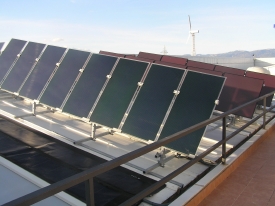Nov 14 2008
Engineers from the University of Zaragoza have developed an algorithm that can optimise hybrid electricity generation systems through combined use of renewable energies, such as photovoltaic and wind power, and non-renewables, such as diesel. Their study, published online in the magazine Renewable Energy, envisions storing the energy in batteries or hydrogen tanks.
 Photovoltaic generator and windmills in the background, Walqa Technology Park in Huesca, Aragón. Picture: Foundation for the Development of New Hydrogen Technologies
Photovoltaic generator and windmills in the background, Walqa Technology Park in Huesca, Aragón. Picture: Foundation for the Development of New Hydrogen Technologies
“The objective of this project is to minimise both the costs and polluting emissions generated by energy production within isolated systems in the electric network, as well as reducing the amounts of unprovided energy (energy required by appliances and devices, but which cannot be supplied)” Rodolfo Dufo, one of the authors of the study and a researcher at the Higher Polytechnic Centre of the University of Zaragoza, told SINC.
The engineers looked at isolated installations, which are provided with electric energy from photovoltaic solar panels, aerogenerators – sometimes known as windmills – and diesel generators, which use electrochemical (normally lead acid) batteries or hydrogen (by means of electrolysers, hydrogen tanks and fuel batteries) for storage. They have also looked into the possibility of redirecting the hydrogen for external uses, such as powering a vehicle, for example. “The optimisation of all these systems is a very complex process, and classic optimisation techniques are not usually appropriate in these cases due to the high computational costs they incur,” said Dufo.
The study, published in the magazine Renewable Energy, is the first time a mathematical algorithm known as SPEA (Strength Pareto Evolutionary Algorithm) has been used for the optimal “multi-objective” designing of hybrid electric energy generation systems.
The algorithm provides an optimum range of solutions (known as ‘pareto’), from which the designer can choose the most appropriate according to the relevant budgetary conditions, acceptable levels of pollutant emissions, and the amount of unprovided energy involved. Optimisation using SPEA allows a range of possible solutions to be obtained “within a reasonably short timescale”.
This method has been used to start testing a new design of isolated energy system using exclusively renewable sources (photovoltaic, wind, hydrogen and batteries), based at the Foundation for the Development of New Hydrogen Technologies’ facilities in the Walqa Technology Park in Huesca, Aragon. The device is already operational, but the researchers are currently working on data collection in order to be able to obtain results to ensure the system’s optimal configuration.
“Given the current energy crisis and the threat of climate change, isolated electrical network systems such as this are going to become ever more important, since they can simultaneously optimise costs, pollutant emissions and unprovided energy”, said the engineer.